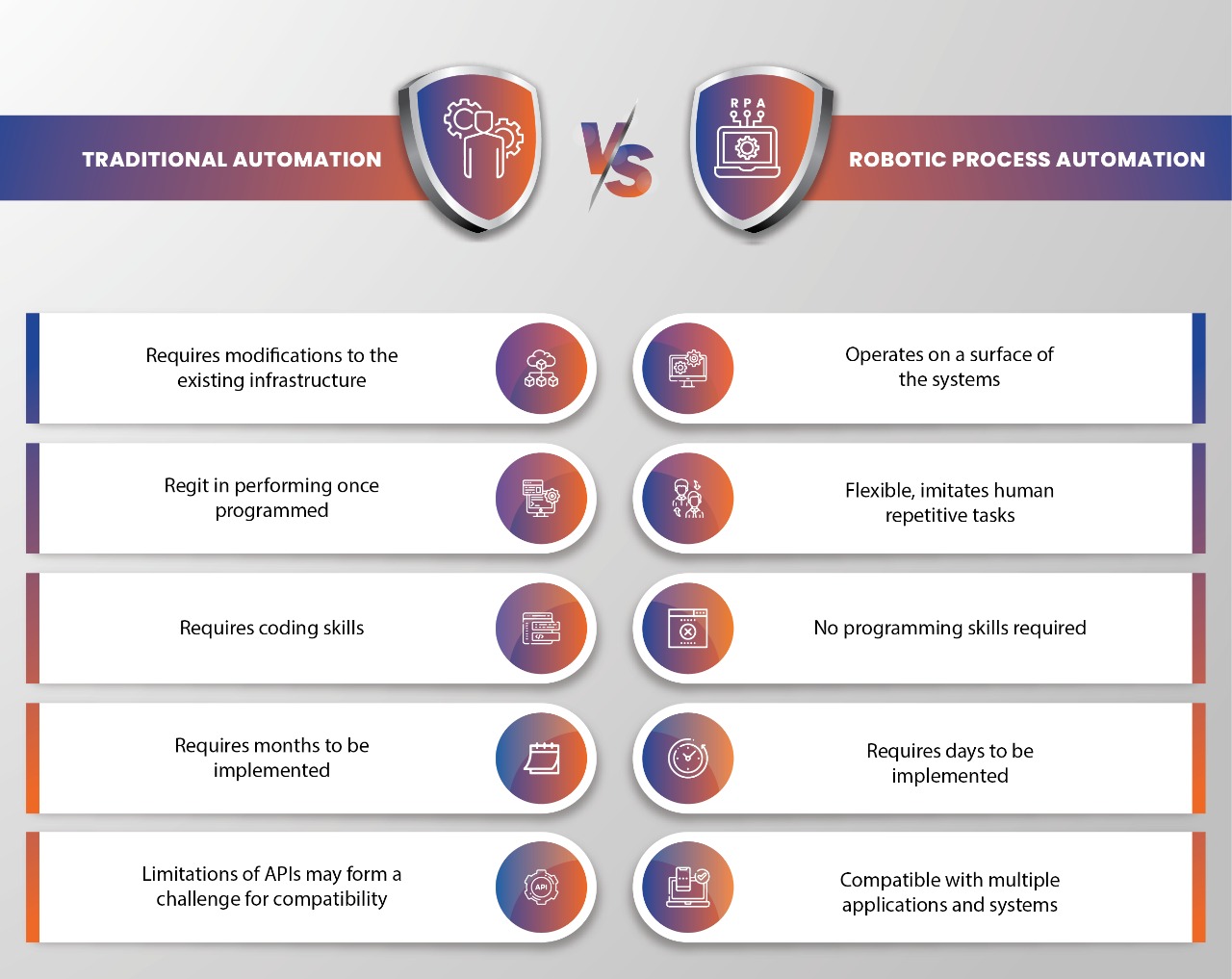- Blog
- February 1, 2022
Traditional Automation vs RPA – Who Wins?

- Blog
- February 1, 2022
Traditional Automation vs RPA – Who Wins?
It seems silly to classify technology as traditional or non-traditional, but that is where we are in the automation industry. Traditional automation is the automation of a repetitive task. While both traditional automation and RPA help to automate processes, traditional automation is found in enterprise production lines where parts are assembled. To conduct traditional automation processes, we require application integration at the database stage. It can take months to set up a traditional automation process.
On the other hand, robotic process automation (RPA) is used when there are lots of repetitive and rule-based tasks to automate. It is software and there are RPA tools that are used to create and integrate “robots” built-in software that can replicate actions from human beings. These “robots” need a set of rules and pre-defined activities to conduct their tasks. They can be set up to execute many tasks and processes in serial and logical order without any human intervention.
Let us look at the differences between RPA and traditional automation:
Use
Traditional automation tools such as selenium can be used to automate any processes conducted in web-based applications. QTP on the other hand can be used to automate desktop applications as well as web applications. Load runner is used for performance test automation. Another example of traditional automation is that it helps to log in and log out of the work system every day when enabled. Each tool under traditional automation serves a specific purpose.
However, RPA works differently from this. Using the RPA software, one can automate any function or process of the business. It works despite the platform is different, so unlike traditional automation, it does not need different platform-based tools. Just like traditional automation, RPA can automate tasks on web applications, desktop applications, mobile applications, and even mainframe applications. It can even automate tasks running on virtual machines. Perhaps there could be a version of RPA which could automate testing as well. A clear example of RPA is the automation of bank account creation. While most companies use back-office executives for this task, others use RPA.

How It Works
Traditional automation tools work on the data layer. They execute the instructions fed into the program of the tool. They do not look to mimic any human actions like RPA. While RPA not only mimics human actions, it is also capable of making the decisions to perform actions once it learns the instructions given to it. RPA goes through the learning phase, after which it becomes capable of decision-making. The decisions are minor.
Programming and Domain Knowledge
In order to get traditional automation tools to work, its user needs to learn programming skills to automate the functions of the tools. Each automation tool is built using different programming languages and the user must be aware of them to use the tools. The user also needs to understand the language syntax. On the other hand, the user does not need to remember language syntax or have programming skills when using RPA. It is like following a flowchart where the user simply needs to understand the RPA functionality rather than any technical language.
For traditional automation, the user must also have the required domain knowledge of the functionality under testing conditions. Usually, a human tester will define all the scenarios of the automation and then a dedicated automation tester will write the script. Similarly, for RPA, users should have a strong base of understanding when it comes to processes and the domain itself. However, there is no separate person who will define the process and write the script.
Customization
Traditional automation cannot work on systems without the APIs to run them. RPA can. So, RPA “robots” can be created to fulfil certain needs that can be as specific as needed. Combining RPA with calendar, email clients, CRM and ERPs is a great way to synchronize information and generate automatic responses. So, in terms of customization, RPA wins!
Cost
RPA is used by businesses to eliminate the need to run boring and repetitive tasks by humans. When a bot does this repetitive work, humans are free to work on something that requires more skill, creativity, and effort. Indeed, RPAs can be used to eliminate errors and generate precise outcomes. Businesses can then focus on a better Return of Investment (ROI).
However, setting up RPA is going to cost way more than setting up traditional automation at the beginning. In the long run, the maintenance and effort needed to run these two clearly show that RPA is the cheaper option. In the long run, traditional automation costs much more than RPA.
Using Traditional Automation and RPA Wisely
While RPA looks like it comes out on top, it cannot fully replace traditional automation. RPA might be the better choice for a lot of applications, but traditional automation still has its place among niche systems and tasks. Traditional automation, for example, would help transfer files between systems more efficiently and quickly than RPA.
However, if a business needs to automate a process in its systems such as data access, invoice creation, and order processing, it can use RPA. This is because RPA works on the UI and helps desk job employees work faster and more efficiently. It can work 24×7, something that a human employee cannot do.
Hence, though RPA might look like the better option, traditional automation is not out of the running yet and it might never be.




